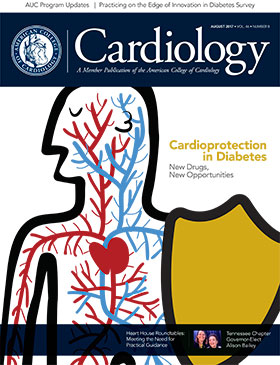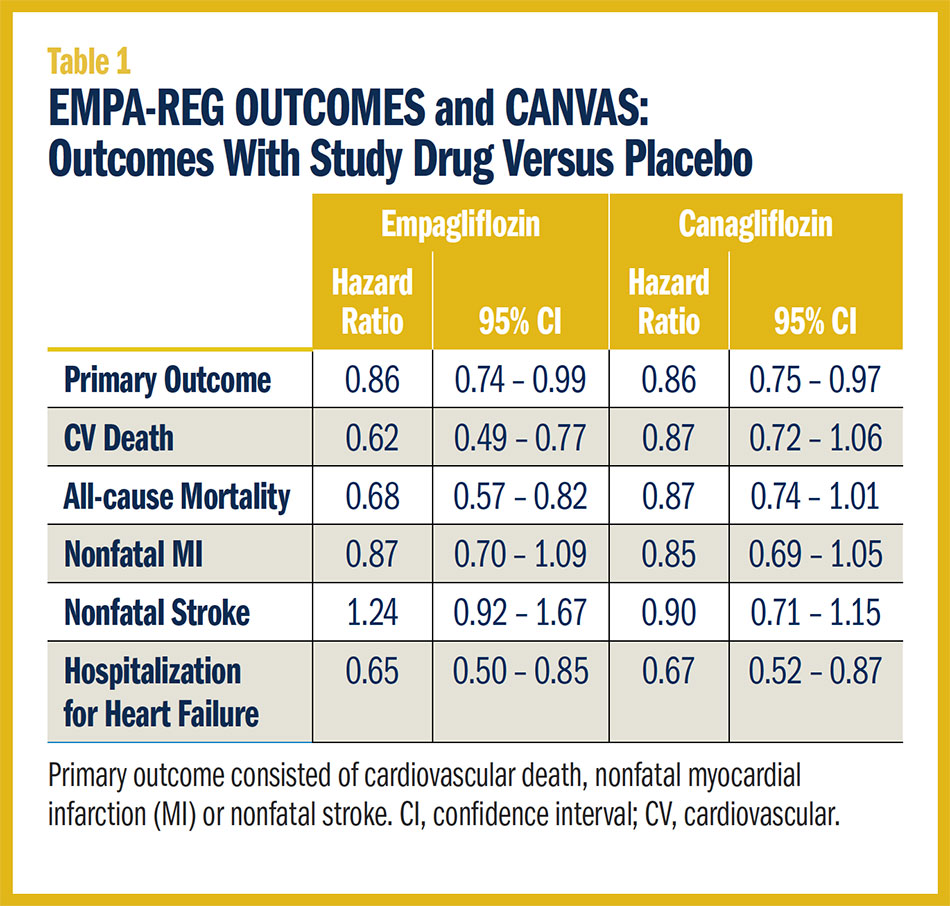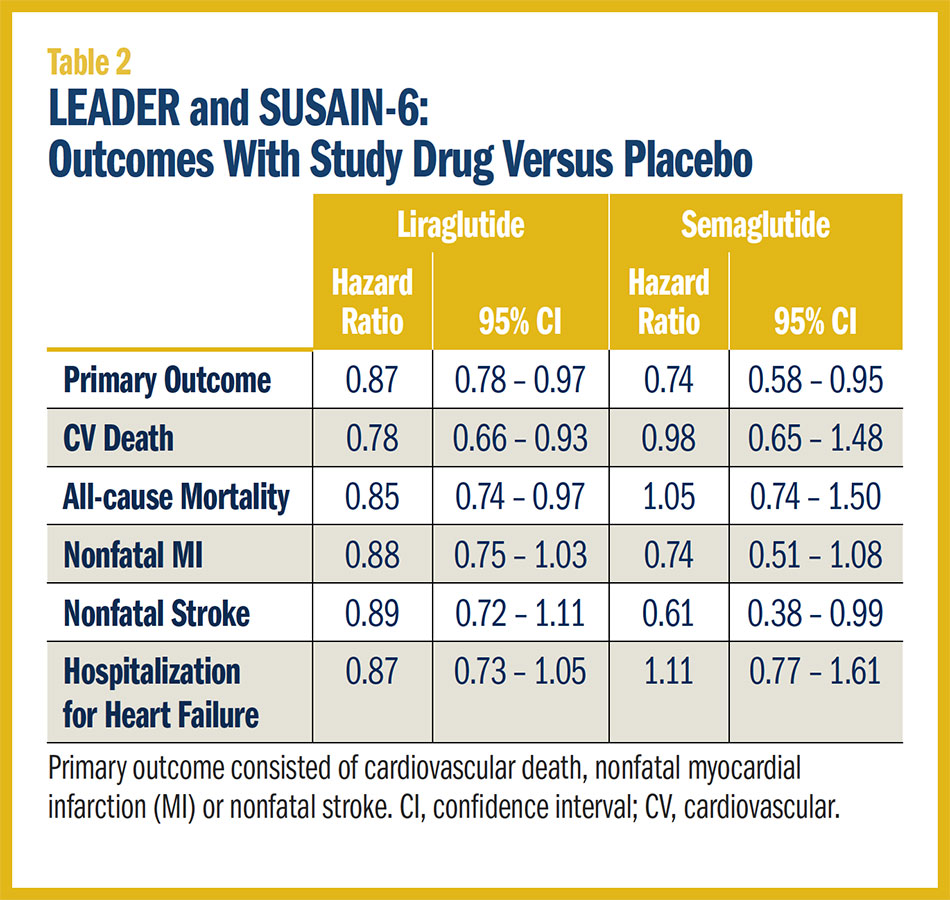Cover Story: Cardioprotection in Diabetes. New Drugs, New Opportunities

Diabetes should be considered a cardiovascular disease. While it impacts the eyes, kidneys, nerves and brain, it's the effects on the large vessels that wreak the greatest consequences, with a two- to three-fold increased risk of cardiovascular disease. Nearly one in 10 Americans has diabetes, and about 65 percent of them will die from cardiovascular disease. And they have a shorter lifespan - about eight years less cardiovascular disease-free life expectancy for adults older than 50 years compared with those who don't have diabetes.
Cardiovascular disease is more likely to be the cause of hospitalization in patients with diabetes than diabetes-related causes. In recent data from the Centers for Disease Control, per 1,000 adults over 18 years old, the hospitalization rate was 70.4 for cardiovascular disease vs. 5.0 for lower-leg amputation and 7.7 for diabetic ketoacidosis.
Abnormal glucose metabolism is but one component of the mechanisms of concern in this setting. Infection, inflammation, hyperglycemia, insulin resistance, dyslipidemia and thrombosis have all been implicated in the development of atherosclerosis and subsequent adverse cardiovascular events in patients with diabetes.
Prevention of cardiovascular events and death must be the goal of diabetes treatment, making it about far more than glucose management. Two new classes of drugs for the treatment of type 2 diabetes (T2D) — sodium-glucose co-transporter 2 (SGLT2) inhibitors and glucagon-like peptide-1 (GLP-1) receptor agonists — have been shown to reduce cardiovascular events, beyond their glucose-lowering benefit. Clearly they change the landscape for cardiovascular professionals and requires them to become active partners in the optimal management and cardioprotection of their patients with established cardiovascular disease or at high cardiovascular risk and T2D.
Indeed, “there is a moral imperative for cardiovascular professionals to become more engaged in the management of diabetes,” says Mikhail Kosiborod, MD, FACC, “because there are agents now that substantially reduce cardiovascular death and other cardiovascular complications.”
Role of Cardiovascular Professionals in Diabetes
“Greater than one-third of patients that the cardiovascular professional sees in the coronary care unit and cath lab have insulin resistance, metabolic syndrome or undiagnosed diabetes,” comments Laurence S. Sperling, MD, FACC. This presents the first opportunity for the cardiovascular professional to become engaged in improving their care — by remembering to suspect and test for diabetes and initiate cardioprotective glucose-lowering treatment if appropriate. This should be a regular part of discharge management, similar with ensuring the prescription of antithrombotic therapy, for example.
While acute, episodic events are frequently a trigger for suspecting diabetes, cardiovascular professionals also are on the front-line for diagnosing diabetes in all their patients with established cardiovascular events. Sperling emphasizes this should not be overlooked, because too often it is exactly that: overlooked. The well-known fragmented care within our health care system means these patients fall between the cracks and no one does the testing, diagnosis or management of the diabetes thinking someone else should do it.
" ...there is a moral imperative for cardiovascular professionals to become more engaged in the management of diabetes because there are agents now that substantially reduce cardiovascular death and other cardiovascular complications." — Mikhail Kosiborod, MD, FACC
However, this does not mean becoming a diabetologist. The cardiovascular professional must be an important member of the team or even the leader and provide what Sperling calls meaningful care. Be comfortable with making a probable diagnosis of diabetes, checking HbA1c and initiating therapy for glycemic control as part of comprehensive medical therapy and cardioprotection. And provide lifestyle and behavioral counseling and a referral to a certified diabetes educator. Within a cardiovascular practice, this diabetes management could be handled by a nurse practitioner, physician assistant or pharmacist.
Comprehensive risk factor management is also required in these patients. A recent analysis from the BARI-2D study showed that the reduction of six risk factors (smoking, cholesterol, triglycerides, systolic and diastolic blood pressure and HbA1c) had the greatest impact on the composite endpoint of cardiovascular events and mortality, beyond the selection of bypass surgery or multivessel PCI.1 Just as cardiovascular professionals have become comfortable with statins for lipid management and blood pressure-lowering drugs for hypertension, this can be extended to new antidiabetic drugs for cardiovascular protection.
“Importantly, a multidisciplinary team approach is required to address cardiovascular disease, including coronary heart disease, stroke and heart failure, in patients with diabetes,” says Nathan D. Wong, PhD, FACC. This is crucial in addressing the significant gap in treatment of the multiple factors involved, with only about a quarter of patients at target levels for HbA1c, blood pressure and LDL-cholesterol. “Studies suggest over half of cardiovascular disease events could be prevented in those with diabetes if these factors were all controlled,”2,3 notes Wong.
“This team should involve the cardiovascular professional as well as the diabetologist/endocrinologist and other crucial members of the “cardiodiabetic” team,” adds Wong, which includes the primary care provider (including nurses and nurse practitioners), dietitian, exercise physiologist, pharmacist, and other specialists as required such as nephrologist, neurologist and vascular surgeon.
"Greater than one-third of patients that the cardiovascular professional sees in the coronary care unit and cath lab have insulin resistance, metabolic syndrome or undiagnosed diabetes." — Laurence S. Sperling, MD, FACC
Sperling affirms this approach noting that the heart team has been successfully embraced by cardiovascular professionals to manage the complexities of care and decision-making in other arenas, such as valvular heart disease or multivessel coronary disease. Ideally, such a team should be an integrated practice unit, and quality metrics for outcomes must be established, along with meeting the goals and preferences of the individual patient. Health systems professionals will be important team members to ensure process development for coordinated multidisciplinary care.
“Collaboration within the team is essential, thus no one specialty should claim ownership,” says Wong. In the case of secondary prevention, it may be the cardiovascular professional who coordinates care, and it may be the diabetologist in patients without established cardiovascular disease but with multiple cardiovascular risk factors.
Whoever coordinates the team, “it’s important the lines of communication are open and that it’s clear the SGLT2 inhibitor or GLP-1 receptor agonist is being prescribed to lower cardiovascular risk,” highlights Kim K. Birtcher, PharmD, AACC. Further, the cardiology clinician should work closely with the primary care provider or endocrinologist to determine the appropriate HbA1c goal for the patient, she adds. And it must be clarified who will monitor the patient’s HbA1c to avoid a treatment gap.
The patient is the key member of the team and as such should be apprised that the medication is for cardiovascular risk reduction in order to improve adherence, adds Birtcher. Additionally, the patient must be informed about the dose, how to take it, what to expect and side effects to report to the prescriber.
New Drugs for Cardioprotection
“Treatment should not be based primarily on HbA1c or glucose levels, but where the patient is on the spectrum of cardiovascular disease and its complications,” says Kosiborod. Preferentially, in patients with established CVD, this should be one of the drugs shown to reduce cardiovascular complications, particularly cardiovascular death, he adds. What are these drugs and what are the data?
Empagliflozin and canagliflozin are oral SGLT2 inhibitors shown to reduce the composite endpoint of cardiovascular death, nonfatal myocardial infarction (MI) or nonfatal stroke compared with placebo on top of standard of care in patients with high cardiovascular risk. Empagliflozin was also shown to reduce hospitalization for heart failure. Liraglutide and semaglutide are injectable GLP-1 receptor agonists shown to reduce cardiovascular death and major cardiovascular events.
Each drug was studied in an international, multicenter, randomized, double-blind trial in patients with T2D at high cardiovascular risk. The primary composite outcome was the same in each trial: cardiovascular death, nonfatal MI or nonfatal stroke.
The EMPA-REG OUTCOME trial with empagliflozin is the first randomized clinical trial in this population to find that a glucose-lowering drug reduced adverse cardiovascular outcomes. In 7,020 patients followed for a median of 3.1 years, the primary composite outcome was reduced by 14 percent with empagliflozin compared with placebo.4 The secondary outcome consisting of the primary outcome plus hospitalization for heart failure was reduced by 11 percent but did not reach statistical significance (p = 0.08). Empagliflozin resulted in a significantly lower risk of cardiovascular death, all-cause mortality and hospitalization for heart failure (Table 1).
More than 90 percent of the patients in EMPA-REG had established cardiovascular disease by study protocol. The mean age of the study population was 63 years and 28 percent were women; 57 percent had T2D for more than 10 years.
In the CANVAS program, a total of 10,142 patients in two trials were randomized to canagliflozin or placebo and followed for a mean of 188.2 weeks. As was the case in EMPA-REG, the primary composite outcome in CANVAS was reduced by 14 percent (p = 0.02).5 The reductions in the other outcomes are shown in Table 1; the effect on heart failure hospitalization was also similar with that seen in EMPA-REG.
The mean age of the patients in CANVAS was 63 years, 36 percent were women and the mean duration of diabetes was 13.5 years; 65.6 percent had a history of cardiovascular disease.
The LEADER trial with liraglutide, injected once daily subcutaneously, included 9,340 patients with a mean age of 64 years; 46 percent were women.6 The median follow-up was 3.8 years. With liraglutide, there was a lower risk of the primary outcome by 13 percent, cardiovascular death and all-cause death (Table 2). The number need to treat (NNT) was 66 to prevent one primary outcome event over 36 months.
In SUSTAIN-6, patients were randomized in a 1:1:1:1 fashion to either semaglutide 0.5 mg (n = 826), semaglutide 1 mg (n = 822) or matching placebo (n = 824 and 825, respectively).7 Both drugs were administered as a subcutaneous injection once a week. The mean age of the patients was 64 years, 39 percent were women, and the mean duration of T2D was 14 years. Established cardiovascular disease was present in 60.5 percent. The median follow-up was 2.1 years.
Semaglutide was associated with a 26 percent reduction in the primary outcome (Table 2). Nonfatal MI and stroke were also reduced. The reductions in outcomes were similar with both doses of semaglutide. The NNT was 45 to prevent one primary outcome event over 24 months.
As with the direct oral anticoagulants and PCSK9 inhibitors when they entered the treatment arena, cardiovascular professionals will need to become familiar with not only the trial data for these new cardioprotective antidiabetic drugs, but also how to prescribe and monitor them and educate patients.
The individual new antidiabetic medications may have subtle but distinct cardiovascular benefits regarding the major cardiovascular endpoint components and side effect profiles, Birtcher comments. And the patient should share in the decision-making on which medication is best while weighing the benefits, potential side effects and their management, drug administration and cost, she adds.
Empagliflozin has received an indication for reducing the risk of cardiovascular death by the U.S. Food and Drug Administration (FDA). Also of note is the reduction in heart failure hospitalization with empagliflozin, which is in contrast to medications from other classes of glucose-lowering drugs that had shown an increase (saxagliptin, alogliptin and rosiglitazone). The rate of serious adverse events and adverse events leading to drug discontinuation were similar in both groups in EMPA-REG OUTCOMES. The most common side effects of empagliflozin were genitourinary infections.
The FDA issued a drug safety communication in May 2017 concerning the increased risk of leg and foot amputations with canagliflozin, based on data reported in the interim safety study in the two individual trials in the CANVAS program. A boxed warning will be added to canagliflozin drug labels. In the CANVAS outcomes study just reported in June 2017, the risk of amputation was 6.3 vs. 3.4 per 1000 patient-years in the canagliflozin and placebo groups, respectively (hazard ratio [HR], 1.97). The highest level of the amputation was at the toe or metatarsal in 71 percent of patients. The absolute risk of amputation was highest in patients who had a previous amputation or peripheral vascular disease. In the CANVAS outcomes study, there was also an increased risk of fracture with canagliflozin vs. placebo (15.4 vs. 11.9 per 1000 patient-years; HR, 1.26). Overall, serious adverse events were lower with canagliflozin than with placebo (104.3 vs. 120.0 per 1000 patient-years) and adverse events that led to discontinuation was similar (35.5 vs. 32.8 per 1000 patient-years). Other adverse effects are genital infection in men and women, volume depletion and diuresis.
In the LEADER trial, the rate of any adverse event and serious adverse event was similar with liraglutide and placebo, but the rate of any adverse event leading to drug discontinuation was higher (9.5 vs. 7.3 percent, respectively; p < 0.001). The most frequent side effects were gastrointestinal in LEADER and SUSTAIN-6. Semaglutide was also associated with higher rates of retinopathy, and the rate of adverse events leading to drug discontinuation was higher with both doses (11.5 percent with 0.5 mg vs. 5.7 percent with placebo; 14.5 percent with 1.0 mg vs. 7.6 percent with placebo). Semaglutide is not yet available in the U.S.
A state-of-the-art review published recently in the Journal of the American College of Cardiology gives the cardiovascular professional a more detailed look at these new antidiabetic drugs.8 Also just published in this journal is a look at measures for the primary prevention of cardiovascular disease in diabetes.9 The ACC is also working to support the cardiovascular professional through the development of patient education resources, leveraging data from the Diabetes Collaborative Registry to identify and capture key learnings and best practices from cardiovascular innovators and holding its first “Managing CV Disease Risk in Diabetes Roundtable.” Learn more about the roundtable in this issue's feature article. Visit ACC.org for the Diabetes and Cardiometabolic Clinical Topic section and the Latest in Cardiology section for trial summaries and updates.
Tweet this article: Tweet
References
- Bittner V, Bertolet M, Felix RB, et al. J Am Coll Cardiol 2015;66:765-73.
- Gaede P, Lund-Andersen H, Parving HH, Pedersen O. N Engl J Med 2008;358:580-91.
- Wong ND, Zhao Y, Patel R, et al. Diabetes Care 2016;39:668-76.
- Zinman B, Wanner C, Lachin JM, et al. N Engl J Med 2015;373:2117-28.
- Neal B, Perkovic V, Mahaffey KW, et al. N Engl J Med 2017;Jun 12:[Epub ahead of print].
- Marso SP, Daniels GH, Brown-Frandsen K, et al. N Engl J Med 2016;375:311-22.
- Marso SP, Bain SC, Consoli A, et al. N Engl J Med 2016;375:1834-44.
- Sattar N, Petrie MC, Zinman B, Januzzi JL. J Am Coll Cardiol;2017;69:2646-56.
- Newman JD, Schwartzbard AZ, Weintraub HS, et al. J Am Coll Cardiol;2017;69:883-93.
 |
|
| Click the cover image above to read the latest issue of Cardiology in e-pub format or click here to read it on the web! | |
Keywords: ACC Publications, Cardiology Magazine, United States, Risk Factors, Metabolic Syndrome, Cholesterol, LDL, Hydroxymethylglutaryl-CoA Reductase Inhibitors, Blood Pressure, Hypoglycemic Agents, Insulin Resistance, Fibrinolytic Agents, Cardiovascular Diseases, Diabetic Ketoacidosis, Coronary Care Units, Smoking, Glucose, Life Expectancy, Pharmacists, Nutritionists, Diabetes Mellitus, Type 2, Antihypertensive Agents, Atherosclerosis, Blood Glucose, Hypertension, Hyperglycemic Hyperosmolar Nonketotic Coma, Hyperglycemia, Dyslipidemias, Life Style, Stroke, Heart Failure, Coronary Disease, Physician Assistants, Thrombosis, Nurse Practitioners, Centers for Disease Control and Prevention, U.S., Amputation, Patient Care Team, Triglycerides, Diabetes Mellitus, Primary Prevention, Preventive Medicine, Secondary Prevention, Exercise
< Back to Listings



